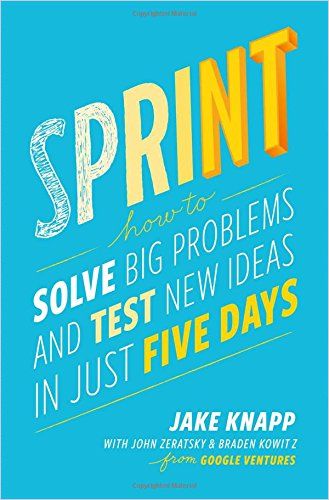The authors detail their Sprint process for turning ideas into testable prototypes.

Racing to Solve Problems
You couldn’t find three guys who do a better job of bringing today’s spirit of finding and applying efficient problem solving to life than Jake Knapp, John Zeratsky and Braden Kowitz. As the pace of change accelerates, even the best ideas have little time to gestate. In that hurried atmosphere, businesspeople must identify, polish, map and test new ideas quickly and thoroughly. In a company such as, for example, Google, nobody has six months to find out if something works. The next idea is already bulleting down the pipeline.
You need to know if your idea – in a clear, marketable form – has legs and can find an audience. If it does, build it. If not, move on. In their role as Sprint consultants at Google, YouTube, Slack, Nest and various VC firms, the authors discovered, codified and applied Sprint thinking under high-pressure circumstances. Their handbook shows you how to run a successful five-day Sprint to identify, name, build, format and test a commercial idea.
Chief executives have posted strong positive reviews of this New York Times and Wall Street Journal bestseller. Ev Williams, a founder of Medium, said, “Read this book and do what it says if you want to build better products faster.” Beth Comstock, vice chair of GE, said, “The genius of… Sprint is its step-by-step breakdown of what it takes to solve big problems and do work that matters with speed and urgency.”
What Not to Do
In his first job at Google, Jake Knapp discovered that brainstorming meetings don’t work. They seldom produce the best ideas or most efficient solutions. Brainstorming is fun but unfocused.
Individual generated ideas were better. When the excitement of the workshop was over, the brainstorm ideas just couldn’t compete.
Jake Knapp, John Zeratsky and Braden Kowitz
Knapp saw that someone who is working obsessively at his or her desk or thinking like mad during a bike ride usually comes up with concepts that the folks at a brainstorming session can’t invent. That discovery got him thinking about a workable combination of the two realms – brainstorming meetings and solo thinking. Then he teamed up with John Zeratsky and Braden Kowitz, and they figured out their step-by-step Sprint strategy.
Immersion
The authors’ method requires five days of intense, focused immersion in closed-door meetings with no more than seven participants. Every Sprint needs a “Decider” – someone with the authority to make decisions. Sprints, the authors make clear, move fast, experiment, reach conclusions and test them with consumers. Knapp, Zeratsky and Kowitz insist that participants leave all their devices – phones, tablets and laptops – behind. They urge you to have two big whiteboards and a supply of healthy snacks. Participants should eat small portions of the snacks to keep their energy from flagging.
Knapp, Zeratsky and Kowitz explain that the people present at a productive Sprint include the person who originated the idea, five experts – in finance, marketing, customer concerns, design and technology/logistics – and one rebel, someone who can buck the status quo that emerges over the five-day Sprint, but who is not a jerk. Choose a facilitator who can be objective about the process. In a perfect world – the authors say with some wistfulness – this should be someone relaxed, charming, patient and known to all.
Monday: Define a Goal and Create a Strategic Framework
Determine the purpose of your project and create a clear, if fairly intricate schematic. The authors provide ample guidance for this step because the map is pivotal: It frames your steps toward identifying the solution to the problem at hand. Knapp, Zeratsky and Kowitz recommend listing all stakeholders: clients, supply chain links, employees, consumers, salespeople and regulators. Write the target goal on the right of your diagram. Connect everything with arrows.
Sprints offer a path to solve big problems, test new ideas, get more done and do it faster. They also allow you to have more fun along the way. Jake Knapp, et.al.
The authors say it’s crucial to make hard choices and never look back. The Decider should choose a single target customer and a single target event.
Tuesday: Discuss Solutions and Then Work Alone
Knapp, Zeratsky and Kowitz suggest examining great techniques other companies are using to address problems like yours. Sketch out your ideal solutions. Don’t linger on any decision. If needed, bring in outside experts to provide information, but for not more than 30 minutes per expert. Then have each person work alone, in silence and under time constraints (say a deadline to finish by the end of the day) to create a three-panel storyboard that shows his or her best idea.
Wednesday: Cull Ideas and Create a Final Storyboard
Sort and compare ideas in the morning, vote and count the votes. Choose one prototype or a combination, and sketch out the winning ideas as a storyboard of 10 to 15 panels showing an outline of your solution, whether it’s a website, a product or an advertising or marketing initiative. If the discussion or the voting stalls, Knapp, Zeratsky and Kowitz are adamant that the Decider makes the call.
Thursday: Build a Prototype of the Sprint’s Final Selection
The authors describe assigning each team member to a defined role. Designate a “Maker, Stitcher, Writer, Asset Collector” and “Interviewer.” Let each person, in his or her role, contribute to the prototype. Have the Decider review it. Then, as Knapp, Zeratsky and Kowitz detail, the Interviewer should write the script for Friday’s interviews with consumers. Line up customers for Friday; buy them thank-you presents, like $100 gift cards.
Friday: Stage and Watch Customer Interviews
The Sprint team gathers to watch client interviews live on webcams. Put your webcam where everyone can read customers’ reactions. Knapp, Zeratsky and Kowitz maintain that only five interviews are all you need. Keep the team together all day, and watch the interviews together. Whether your prototype fails, hits big or is a partial success, you will learn a lot for its next iteration.
Wrapping Up
The authors provide painstaking explanations for every moment of the five days. Even so, their reliance on jargon and their assumption that all firms work like Silicon Valley companies sometimes slow the reader down. Maybe they’re aiming at a certain demographic, or maybe readers older than gen X may need to reread certain sections or find a younger colleague – or a Californian – to translate.
The bigger the challenge, the better the Sprint.Jake Knapp, et.al.
The authors are smart, articulate, enthusiastic, passionate and only slightly repetitive. As you read, you’ll be bursting with new ideas of ways to apply their approach to your familiar problems or emerging projects. Their manual and methods will appeal to venture capitalists, sole practitioners, corporate department heads and anyone who has a great concept, but doesn’t know where to start.
Other books about moving quickly and finding the best methods for bringing ideas to light – and to implementation – include Inspired by Marty Cagan, The Lean Startup by Eric Ries, Don’t Make Me Think by Steve Krug and Hooked by Nir Eyal.













